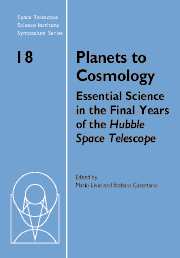 Planets to Cosmology
Planets to Cosmology Book contents
- Frontmatter
- Contents
- Participants
- Preface
- Hubble's view of transiting planets
- Unsolved problems in star formation
- Star formation in clusters
- HST abundance studies of low metallicity stars
- Physical conditions and feedback: HST studies of intense star-forming environments
- Quasar hosts: Growing up with monstrous middles
- Reverberation mapping of active galactic nuclei
- Feedback at high redshift
- The baryon content of the local intergalactic medium
- Hot baryons in supercluster filaments
- Galaxy assembly
- Probing the reionization history of the Universe
- Studying distant infrared-luminous galaxies with Spitzer and Hubble
- Galaxies at z ≈ 6–i′-drop selection and the GLARE Project
- The Hubble Ultra Deep Field with NICMOS
The baryon content of the local intergalactic medium
Published online by Cambridge University Press: 17 August 2009
- Frontmatter
- Contents
- Participants
- Preface
- Hubble's view of transiting planets
- Unsolved problems in star formation
- Star formation in clusters
- HST abundance studies of low metallicity stars
- Physical conditions and feedback: HST studies of intense star-forming environments
- Quasar hosts: Growing up with monstrous middles
- Reverberation mapping of active galactic nuclei
- Feedback at high redshift
- The baryon content of the local intergalactic medium
- Hot baryons in supercluster filaments
- Galaxy assembly
- Probing the reionization history of the Universe
- Studying distant infrared-luminous galaxies with Spitzer and Hubble
- Galaxies at z ≈ 6–i′-drop selection and the GLARE Project
- The Hubble Ultra Deep Field with NICMOS
Summary
In this review, we describe our surveys of low column density (Lyα) absorbers (NHI = 1012.5−16 cm−2), which show that the warm photoionized IGM contains ∼30% of all baryons at z ≤ 0.1. This fraction is consistent with cosmological hydrodynamical simulations, which also predict that an additional 20–40% of the baryons reside in much hotter 105−7 K gas, the warm-hot IGM (WHIM). The observed line density of Lyα absorbers, dN/dz ≈ 170 for NHI ≥ 1012.8 cm−2, is dominated by low-NHI systems that exhibit slower redshift evolution than those with NHI ≥ 1014 cm−2. HST/FUSE surveys of OVI absorbers, together with recent detections of OVII with Chandra and XMM/Newton, suggest that 10–40% of all baryons could reside in the WHIM, depending on its assumed abundance (O/H ≈ 10% solar). We also review the relationship between the various types of Lyα absorbers and galaxies. At the highest column densities, NHI ≥ 1020.3 cm−2, the damped Lyα (DLA) systems are often identified with gas-rich disks of galaxies over a large range in luminosities (0.03–1 L*) and morphologies. Lyman-limit systems (NHI ≥ 1017.3−20.3 cm−2) appear to be associated with bound bright (≥ 0.1–0.3 L*) galaxy halos. The Lyα absorbers with NHI = 1013−17 cm−2 are associated with filaments of largescale structure in the galaxy distribution, although some may arise in unbound winds from dwarf galaxies. Our discovery that ∼20% of low-z Lyα absorbers reside in galaxy voids suggests that a substantial fraction of baryons may be entirely unrelated to galaxies. In the future, HST can play a crucial role in a precise accounting of the local baryons and the distribution of heavy elements in the IGM. […]
- Type
- Chapter
- Information
- Planets to CosmologyEssential Science in the Final Years of the Hubble Space Telescope: Proceedings of the Space Telescope Science Institute Symposium, Held in Baltimore, Maryland May 3–6, 2004, pp. 111 - 129Publisher: Cambridge University PressPrint publication year: 2006
- 5
- Cited by


